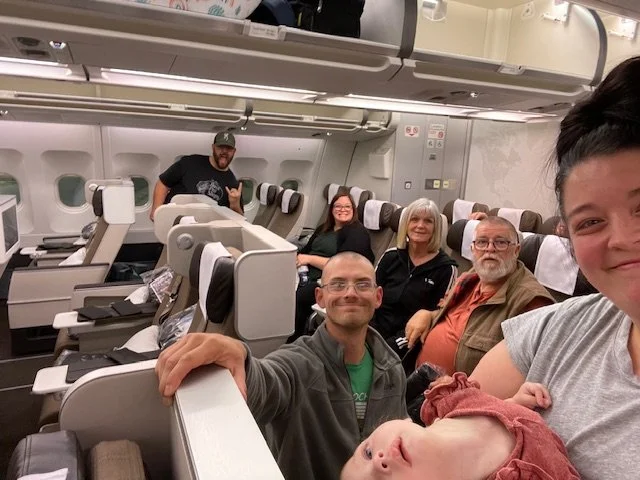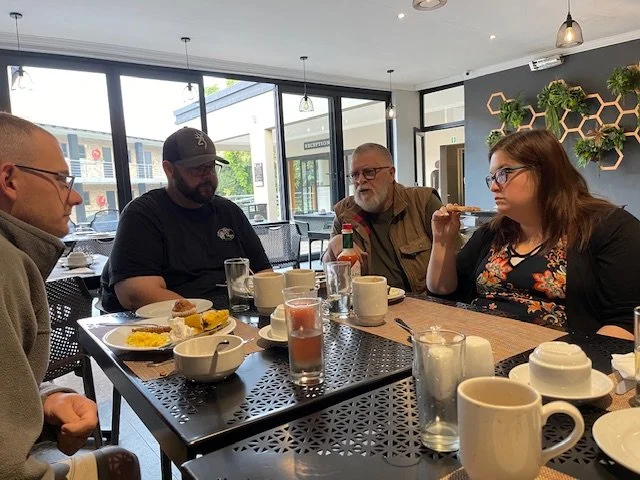4. First nights
Our landing at Oliver Tambo International Airport in Johannesburg/Gauteng was far less traumatic than some had worried it would be. We passed through customs and immigration almost uneventfully and were met by a dear friend I had not seen for many years.
Mike Nomtoto was part of the last graduating class under my father at Southern Africa School of Theology (SAST). He views himself as my younger brother. It was such a delight to see him and I am sure that he came many hundreds of kilometers just to meet us at the airport. He went with me to the car rental agency where I picked up our 14-seat van, and then spent a few short moments with us before we had to leave. His sacrifice to be there when we arrived was not something I will soon forget.
We were to spend the first night in the little town of Brits, west of Johannesburg and near the town I grew up in, Rustenburg. Sadly, we had to cancel our visit to Rustenburg due to the time and distance it would have taken.
The plan was to begin the trip on the very first day with a visit to the Voortrekker Monument. The monument sits between Johannesburg and Pretoria to the north. I wanted the family to visit this monument as it really helps with understanding what South Africa is really all about.
The “voortrekkers” were the Dutch pioneers who settled South Africa. The English also settled but were not known by this name.
The Voortrekker Monument commemorates a very famous battle that took place in 1836 between the voortrekkers and Zulus in what is today KwaZulu-Natal. According to the Dutch (White) version of the event, the voortrekkers prayed that God would help them conquer the Zulus. The Zulus were already renowned for their prowess on the battlefield with other nations.
The ensuing battle was fierce and bloody. What amounted to a handful of Dutch settlers was able to repel the might of the Zulu army. Of course, the settlers had guns while the Zulus only had spears and shields. In any case, the voortrekkers won the battle and a monument was built and commemorated on December 16th 1936, the centenary of the Battle of Blood River as it had become known.
The monument is massive. It is about 132 feet high and measures 132 feet by 132 feet at the base. Every year on December 16th, the sun shines through a tiny hole on the top and shines on a marble slab in the basement that reads “Ons Vir Jou Suid-Afrika” (We for you, South Africa).
After climbing stairs to reach the ground floor, you can see this marble slab by looking over a railing into the basement. The walls of the ground floor have a depiction of the battle on the walls in beautiful relief. There is also a museum in the basement area. The entire monument is surrounded by a wall with wagons in relief simulating the encircled wagons before the battle.
The amazing thing to me, is that the monument was not dismantled or destroyed when the white-un apartheid regime fell in 1994. President Nelson Mandela declared that the monument should stand as it represents South African history, whether good or bad.
This monument, I felt, was a great beginning to explain some of the complexity of the racial struggles that cloud South Africa’s history.
Brits was the first of many shocks for me. It will be difficult to explain the reason without sounding completely racist. You see, towns in South Africa that had been completely white populated are now very multi-racial and often more like African culture would be. This can be and often is very intimidating. Brits was no exception. It was very run down and the area we were supposed to stay in was heavily populated with cheap African taxis and buses and people who did not look to be very friendly to tourists. We circled the area for the hotel a couple of times before we finally found the hotel in the middle of a high security fenced-in area.
The hotel was safe and our stay was uneventful. In fact, at breakfast the next morning, there was a group of high-ranking police officers who had also been staying there. This helped to relieve some of the tension that our group had been feeling. It was difficult to forget that we had been held up and robbed during a previous trip. We needed to know that we were safe. The police presence helped.
I had already decided to forego visiting Rustenburg, the town where I grew up. This was because of time and distance to Kruger National Park.





